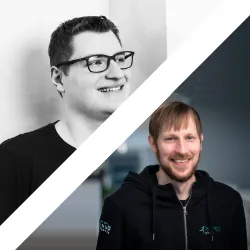Goals of the workshop
-
Develop a understanding of sustainability impact decisions such as model selection on the overall architecture and efficiency of AI projects.
-
Deepen understanding through interactive exercises
-
Illustrate architecture and design decisions that play a central role in AI-focused software projects.
Key info
- Target Group: Users and software engineers who integrate AI into their applications. We do not cover the construction or optimization of models from scratch or the hardware itself.
- Format: Interactive Workshop
Workshop Host

Florian Bartling / Philipp Dressler
Details about the workshop host
Details about the workshop host #2
Description
This workshop provides a concise and understandable explanation of why artificial intelligence (AI) is so relevant to green IT and why it will become even more important in the future. We will look at the factors that play a role here and why it is not a good idea to completely ignore AI in this context.
We will then examine the current impact of AI and discuss whether and how this can be measured. We will also look at the problems that arise in this context.
In the practical, hands-on part of the workshop, we will see how quickly small changes can be made. We will discuss which decisions are important when starting your own AI projects.
The workshop thrives on open exchange and offers the opportunity to try everything out in a sandbox environment.
Agenda
Part 1: AI and Green IT – Overview (approx. 45 minutes)
- Relevance of AI for Green IT: Current and future impact of AI on the environment, compared to the overall picture.
- Key factors: Interaction between hardware efficiency, algorithms, data and cloud strategies, and model selection.
- AI use as a necessity: Why foregoing AI technologies contradicts the three pillars of sustainability.
- Interactive exchange: Q&A and open discussion.
Part 2: Understanding and measuring impact (approx. 30 minutes)
- Current AI impact: Emissions and resource consumption during the training and operation of AI models.
- Measurement methods: Tools and metrics for recording energy consumption and CO2 emissions (e.g., token and cost proxies).
- Measurement challenges: Typical pitfalls.
- Interactive exchange: Discussion and best practice sharing.
Part 3: Hands-on: Green AI in practice (approx. 45 minutes)
- Small changes, big impact: Practical, interactive example of AI usage and engineering for applications.
- Important decisions in AI projects: Why AI projects are primarily software engineering, from architecture to model selection.
- Sandbox environment: Experimenting with tools and concepts using examples.
- Interactive exchange & questions: Joint solution finding and outlook.
Note: The workshop is aimed at users and software engineers who integrate AI into their applications and daily works. We do not cover the construction or optimization of models from scratch or the hardware itself.